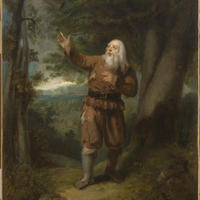More about Henry Inman
Works by Henry Inman

Contributor
Henry Inman proves that sometimes, despite whatever your other accomplishments may have been, you’ll be most remembered for being derivative.
His most lasting work is a series of reproductions of portraits of Native American delegates. The originals were part of a long-term exhibition in the Smithsonian, sponsored by the federal government in a push to honor the indigenous people of America and their pre- and post-colonial history. Many of these, such as the portrait of Sequoyah, were painted by successful Vermont portraitist Charles Bird King. These paintings were so popular that Inman created copies of many, for commercial publishing purposes. In the pre-internet era, professional plagiarism was the best way to see art without going to a museum. Inman’s copies actually ended up replacing the originals, when the entire gallery of nearly three hundred portraits burned down in the 1865 Smithsonian Castle fire.
Outside of his perhaps unoriginal, but history-preserving famous artwork, Inman also was instrumental in the creation of the National Academy of Design, of which he was the first vice president. In the 1820s, the most powerful organization that supported artists, through funding and exhibitions, was the American Academy of the Fine Arts. However, it was ran by businessmen, as opposed to actual artists. Their prioritization of capitalism over creativity led to clashes with the art students they were supposed to be aiding, and a group of them eventually split off to form their own group in 1828, which would serve the same function, but this time led by real artists. The structure was understandably appealing to contemporary artists, and within a decade the National Academy of Design had overtaken its predecessor, and the American Academy of the Fine Arts became defunct.
The National Academy of Design still exists today, and artists who have been deemed to have “made a significant contribution to American culture” can be elected to be “Academicians.” Since this practice has been going on for nearly two centuries, there are hundreds, if not thousands, of people who have received the honor, but it would be interesting to see how the list of Academicians breaks down along race and gender lines (hint, hint, to any statistics-minded art historians who happen to be reading this—sounds like a great thesis topic).
Sources
- “Henry Inman.” National Gallery of Art. Accessed July 25, 2018. https://www.nga.gov/collection/artist-info.1412.html
- “Historical Overview.” National Academy of Design. Accessed July 30, 2018. https://www.nationalacademy.org/historical-overview/
- “National Academicians.” National Academy of Design. Accessed July 30, 2018. https://www.nationalacademy.org/national-academicians
- "The National Academy of Design." National Academy Notes including the Complete Catalogue of the Spring Exhibition, National Academy of Design, no. 4 (1884): 127-38. http://www.jstor.org/stable/25608025.
Featured Content
Here is what Wikipedia says about Henry Inman (painter)
Henry Inman (October 20, 1801 – January 17, 1846) was an American portrait, genre, and landscape painter.
Check out the full Wikipedia article about Henry Inman (painter)












